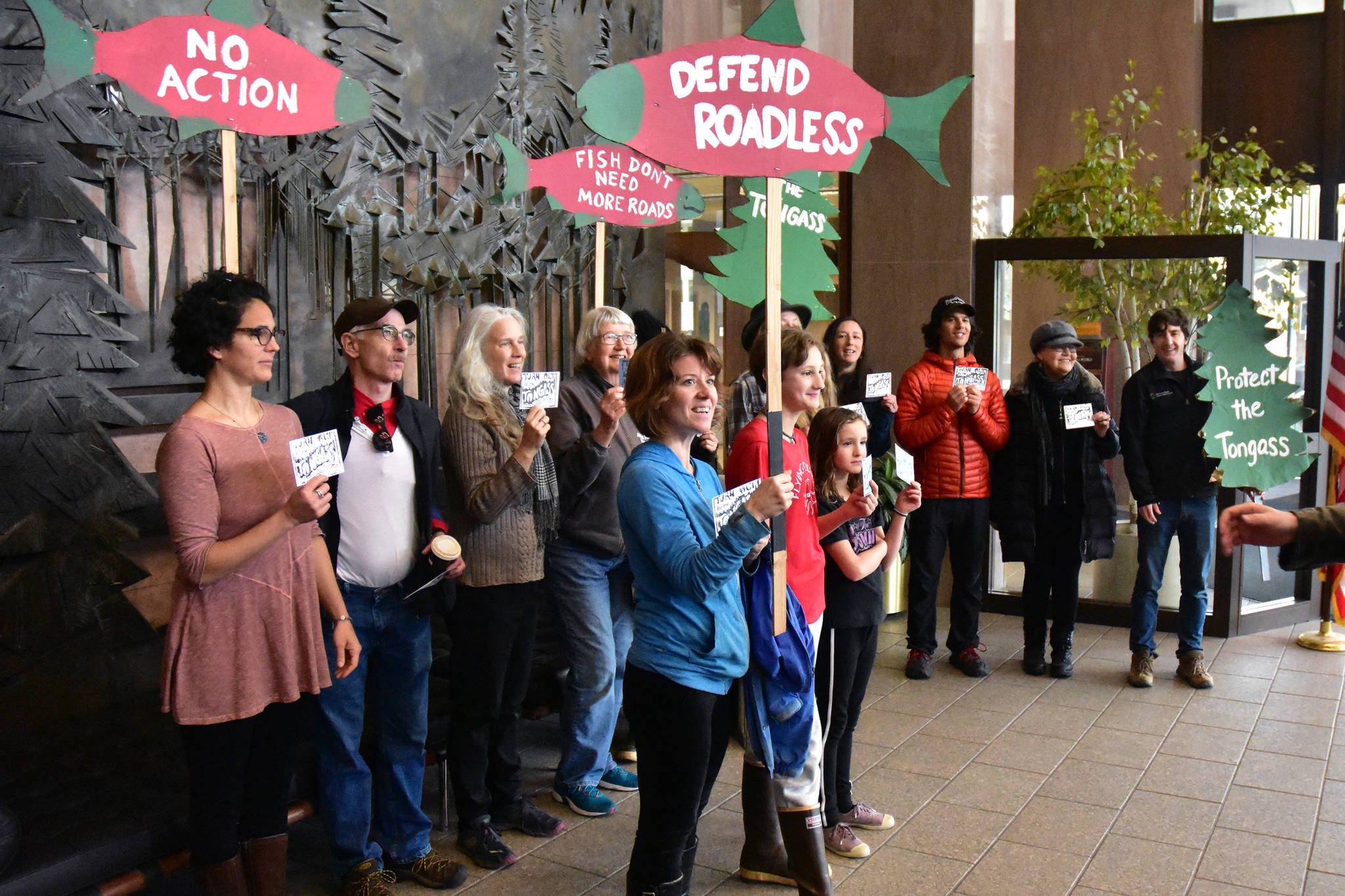About a dozen protesters gathered at the Hurff A. Saunders Federal Building in downtown Juneau Monday to submit over 200 written comments in support of keeping the “Roadless Rule” intact on the Tongass National Forest.
The protesters, organized by the Southeast Alaska Conservation Council, were responding to the U.S. Forest Service’s Oct. 15 announcement that it was seeking public comment for a Draft Environmental Impact Statement (DEIS) on proposed alternatives to the Alaska Roadless Rule.
Protestors delivered the comments to a box prepared by the Forest Service located on the fifth floor of the Federal Building. As the comments were being delivered, they chanted “Roadless” but in voices just above a whisper, so as not to cause a disturbance.
The 2001 Roadless Rule is a law which largely prohibits any road building on roughly 58.5 million acres of National Forest lands. Since its implementation, the Roadless Rule has been a source of controversy between environmentalists, who see the law as an essential protection on a critical habitat, and others who view it as prohibiting necessary development.
Politicians praise, conservationists condemn effort to amend Roadless Rule.
Meredith Trainor, SEACC executive director, said the Roadless Rule was necessary to prevent future logging on the Tongass. Her organization had been collecting comments throughout the summer in anticipation of the announcement that Roadless Rule alternatives were being examined.
“These comments are all of what people get out of the Tongass and why they love the Tongass,” Trainor said. “They’re also focused on what those values are that people share for the Tongass National Forest.”
Trainor said that SEACC had collected around 200 written comments over the summer but that roughly 800 comments had come in via the organization’s website since the announcement on Oct. 15.
One protester, Lea Harris, said she hadn’t heard about the demonstration beforehand but once she saw what was happening she knew she had to join in.
“I’m all about this,” she said. Harris is retired and lives in Haines. She said she was on her way to the post office when she saw the protestors carrying signs supporting the Roadless Rule.
“I don’t want them breaking the Tongass,” Harris said. “It’s bad for the environment and the ecosystem.”
Protesters urged Secretary of Agriculture Sonny Perdue to choose the “no action” alternative from among the list of options put forward by the Forest Service. That option would make no changes to the 2001 Roadless Rule.
The U.S. Department of Agriculture’s preferred alternative would exempt 9.2 million acres of forest from the Roadless Rule and convert 185,000 acres of previously unsuitable timber lands to suitable status.
“As we see this attack from the Trump administration on public lands across the board,” Trainor said, “it’s important that we keep every single piece of these protective policies in place and in place now.”
But others see the Roadless Rule as too burdensome, preventing the construction of critical infrastructure. Robert Venables, executive director of Southeast Conference, brought up the example of an electrical intertie project between Petersburg and the Organized Village of Kake.
The 2001 Roadless Rule does allow for certain exceptions, “But those exceptions come with strings,” Venables told the Empire. That project, “got permitted with such restrictions that it drove up the cost that it’s not going to get built now.”
Jim Clark, former chief of staff to Gov. Frank Murkowski and currently an attorney for a number of resource industry companies, said that there are already several layers of protections already on the Tongass.
Clark pointed to the Alaska National Interest Lands Conservation Act of 1980 and the Tongass Timber Reform Act of 1990 as two federal laws which already provided several protections for the Tongass.
Roadless Rollback? Dunleavy and Trump eye Tongass National Forest.
“It’s not like all the restrictions are being lifted,” Clark said.
National forests must have a Land and Resource Management Plan, Clark said. Those plans, unlike the Roadless Rule, can be amended to suit local needs.
Lifting the Roadless Rule, Clark said, “would return control to local people as opposed to going through national rule making.” Amendments to a forest plan are still subject to scrutiny under the National Environmental Protection Act, Clark said.
But environmentalists are still convinced that the Roadless Rule is critical in preserving an important natural resources, particularly in a time of climate crisis.
“The Tongass is the largest intact Pacific temperate rainforest region in North America, and is a “carbon life-raft” for maintaining America’s resilience in the face of the climate crisis,” a SEACC press release said.
Public comment on the DEIS for the Alaska-specific Roadless Rule exemption will be accepted until Dec. 17, 2019 and can be made to the Forest Service website.

